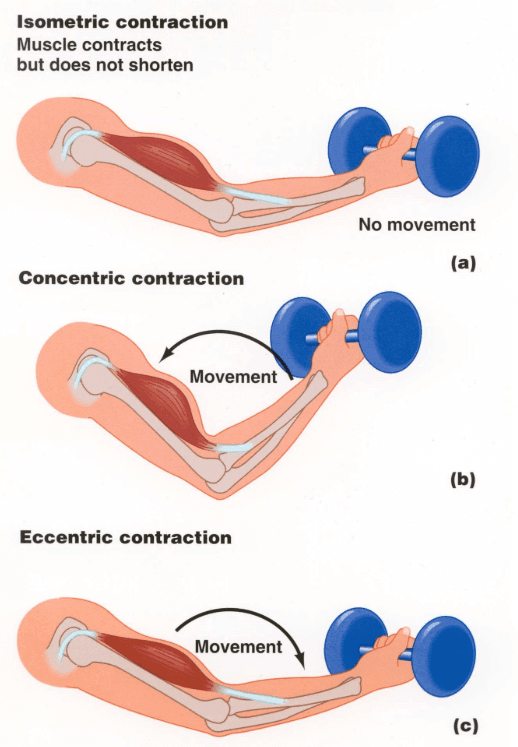How should you think about the benefits during lifting (concentric) and lowering (eccentric) of the weight during your workout?
Resistance training involves two types of movements, concentric and eccentric. Concentric movement is when the muscle shortens while producing force (contracting the muscle). This happens when you are raising the weight during a biceps curl.
Eccentric movement is when the muscle lengthens while producing force. For example, when you’re lowering the weight back down during a biceps curl. One can say that you’re often stronger in the eccentric phase of the lift since you’re holding back the weight.
Eccentric Training Creates More Muscle Damage
Both movements are said to lead to increased hypertrophy/muscle mass. Some evidence suggests that eccentric training promotes muscle mass more than concentric. This may be due to a more rapid response of muscle building (anabolic) signaling and induced muscle damage.
The hypothesis is that more muscle damage mediates a greater anabolic response, and that response strengthens the muscle. However, no one really knows the exact mechanism that causes muscle to grow, and we have previously written about the relationship between muscle damage and muscle growth.
Most studies favor the eccentric movement to produce a higher increase in muscle hypertrophy compared with concentric training, however, the difference in effect is very small – on average 3.2% more muscle growth from eccentric movements, without statistical significance (1–2).
If There is a Benefit it is Probably Very Small
There is no difference in muscle hypertrophy between concentric and eccentric training, according to several studies with the same conclusion (3–5). There may be a slight advantage to eccentric but if there is, it’s a very small one and probably not significant.
It Might Just Be the Weight!
Loading differences between the two movements can contribute to the small advantage of eccentric lifting. During eccentric lifting one often tend to use a heavier weight. It may also be because you’re nearing your maximum and therefore lifting more weight. Growth-related effects of eccentric training appear to be related to the higher loads developed during eccentric contractions (6–8).
Start Building Muscle
Is your workout plan actually working? With Dr. Muscle, you won’t have to worry about that. Let us handle all the logistics. Relax, enjoy your workouts, and focus on lifting heavy and getting buffed.
Eccentric vs Concentric: Understanding the Differences in Muscle Movements
When it comes to exercise and physical training, the terms “eccentric” and “concentric” refer to two distinct types of muscle contractions that play a crucial role in how we perform movements. Understanding these differences can help you optimize your workouts and improve your overall strength and performance.
What is Eccentric Contraction?
Eccentric contraction occurs when a muscle lengthens while under tension. This type of movement is often associated with the lowering phase of an exercise. For example, when you lower a weight during a bicep curl, your bicep muscle is undergoing an eccentric contraction. Here are some key points about eccentric contractions:
- They help in controlling the speed of movement.
- They are essential for activities that involve deceleration, such as running downhill.
- Eccentric training can lead to greater muscle hypertrophy and strength gains.
What is Concentric Contraction?
In contrast, concentric contraction occurs when a muscle shortens while generating force. This is typically seen in the lifting phase of an exercise. For instance, when you lift a weight during a bicep curl, your bicep is performing a concentric contraction. Here are some important aspects of concentric contractions:
- They are responsible for overcoming resistance and initiating movement.
- Concentric contractions are crucial for explosive movements, such as jumping or sprinting.
- Training with concentric contractions can enhance overall power and strength.
Take Home
Both concentric and eccentric movements seems to be equally important for muscle growth during resistance training. So go out there a lift! (1).
Article written by Maria Ekblom.
2. 1007/s00421-011-2078-x
3. 3389/fphys.2017.00447
4. 1111/apha.12225
5. 1111/sms.12104
6. 1007/s11357-012-9405-y
7. 1016/j.jsams.2015.12.431
8. 1136/bjsm.2008.051417









